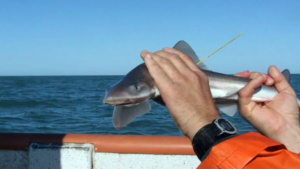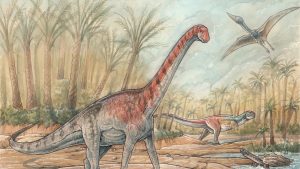The great mystery about the origin of pterosaurs was revealed
An international team of paleontologists revealed one of the biggest questions in vertebrate paleontology and evolutionary history, discovering a terrestrial relative of pterosaurs, the flying reptiles that dominated the skies during the Age of the Dinosaurs and included the largest flying animals ever.
Emanuel Pujol (CTyS-UNLaM Agency) - Pterosaurs spread around the world during the time of the dinosaurs. They usually appear in books and movies, but, for more than 200 years, until today, their origin was unknown. In the fossil record, no closely related species or group of reptiles has ever been found to show how these reptiles evolved to conquer the sky. This great gap in the fossil record was completed from a study carried out by a large international team of Argentine, American, Brazilian and European paleontologists.
Dr. Martín Ezcurra, one of the heads of the Vertebrate Paleontology Section of the Argentine Museum of Natural Sciences (MACN) and a researcher at CONICET and the University of Birmingham, told to the CTyS-UNLaM Agency that “the first pterosaurs were found during the late eighteenth century and, from that time, it was observed that they had an anatomy, a body plan that was very different from that of other known reptiles, having wings formed by membranes, supported by an hyperdeveloped fourth finger of the hand (the ring finger in humans), which is a unique feature of pterosaurs”.
"Since then, and during the next 250 years, one of the main mysteries of vertebrate paleontology was who were the closest terrestrial relatives of these flying reptiles and thus be able to understand how this evolutionary transition occurred", added the lead author of this study published today in the prestigious scientific journal Nature.
Thus, this new study fills a large gap, by revealing which were the terrestrial relatives of pterosaurs, these flying animals that arose about 220 million years ago and that coexisted with dinosaurs during almost the entire Mesozoic Era, until they shared their extinction 66 million years ago.
"This discovery was produced from a combination of different findings that we had been making in search to better understand the origin of dinosaurs", Ezcurra said. And he specified: “One of the groups that were considered as dinosaur precursors are the enigmatic lagerpetid reptiles, of which very few parts of their body were known. But, based on new findings of the jaw and skull of lagerpetid species in Brazil, Argentina and the United States, we were able to detect that these terrestrial reptiles were closely related to the famous pterosaurs”.
Doctor Federico Agnolin, a researcher at the MACN, CONICET and the Azara Foundation, highlighted that “the origin of the flying reptiles was one of the great enigmas of paleontology and evolutionary biology as a whole. Now, we know that there was an intermediate step in the lagerpetids, terrestrial reptiles that look similar to a lizard, which could not fly, but that, in this study, we could already observe some evolutionary steps in their brain and inner ears that were adaptations that later would have allowed pterosaurs to develop flight.
For this research, pterosaurs were compared with different lagerpetid species, whose oldest specimens - more than 230 million years old - measured between one meter and one and a half meters, while the most recent - about 210 million years old - reached three meters in length.
Dr. Fernando Novas, led of the MACN Comparative Anatomy Laboratory, recalled how the discovery occurred: “In 2018, Martín Ezcurra called me and said: 'I was in Brazil and I saw materials from a lagerpetid reptile from 233 million years old that has a remarkable resemblance in the teeth of its jaw to pterosaurs”.
“The truth is, previously, we had already studied in the Comparative Anatomy Laboratory of the MACN a block of rock that had been found in 1966 in La Rioja, in the Talampaya National Park, and that contained inside the skeleton of a lagerpetid”, Novas continued.
In this regard, Ezcurra related: “When we analyzed the lagerpetid from La Rioja, we saw these very rare characteristics in the dentition and we considered the possibility that it was part of this species called Lagerpeton chanarensis or that it wasn’t a lagerpetid. We were not certain, but when we later saw the lagerpetid from Brazil accompanied by a jaw with similar characteristics, we were able to confirm that these pterosaur-like teeth belonged to these lagerpetids”.
In this way, it was possible to compare the pterosaurs not only with the lagerpetid from Argentina (Lagerpeton, 236 million years old), but also with the lagerpetid found in southern Brazil in 2016 (Ixalerpeton, 233 million years old antiquity). But there was still more information that would be incorporated into this revealing international study, because, in recent years, remains of other lagerpetids had also been found in the United States.
“In 2007, a new species of lagerpetid was found in the state of New Mexico, with an approximate age of 212 million years, while the land reptile of La Rioja is much older, so this comparative study allowed us to compose a broad and reliable panorama that unveils the relationship of these terrestrial reptiles with pterosaurs as well as to describe the lagerpetids themselves, which were a fairly unknown group”, said American paleontologist Sterling Nesbitt of Virginia Tech.
Regarding the specimens found in South América, Dr. Max Langer, from the Laboratory of Paleontology of the University of São Paulo, stated: “The rocks of the Triassic age of southern Brazil and northwestern Argentina harbor fossil treasures unprecedented in the world. This includes the oldest dinosaurs, some of the oldest turtles and crocodiles, as well as mammal precursors. Now, the evolutionary history of the flying reptiles is also present in South America, in the form of their closest relatives, the lagerpetids”.
Dr. Ezcurra stated that “the specimens that were appearing in different parts of the world seemed to indicate that lagerpetids could be closely related to pterosaurs, but this evidence corresponded to different research groups and, separately, robust evidence could not be established, so we combine all these sources of information from different specimens and from there the authors of this study ended being 18 researchers from six different countries”.
"This work began in 2018 and, from then until the middle of this year, one of the most important tasks was to create a data matrix broad enough to be able to analyze the relationships of pterosaurs with the different groups of Triassic reptiles", Ezcurra described.
This whole study gathers more than 820 skeletal brain characteristics, as well as features of the inner ear, using 158 species of fossil reptiles from different parts of the world. In this way, the authors were able to sustain very strongly this revealing new relationship between lagerpetids and pterosaurs.
Brain and ear: two evolutionary adaptations to be able to fly
Dr. Federico Agnolin said that, until now, only a few lagerpetid remains were known, mostly the hips, hind legs and tail: “In this study, we gathered much more information and, by obtaining CT scans from the skull, we were also able to know how the brain of these terrestrial reptiles looked like”.
“From the CT scans, we discovered that lagerpetids also shared a number of unique characteristics with pterosaurs, which allowed them to have greater agility. One of these characteristics is that in the cerebellum of lagerpetids and pterosaurs there is a structure called flocculum, which is highly developed in both, which is interpreted as an evolutionary adaptation that gave them a greater capacity for processing information; for example, between the eye, the rest of the head and the members of the body, so they could have greater visual coordination”, Ezcurra explained.
“The relationship of the brain with movement, agility and this great apparatus of senses, are qualities necessary for animals to be able to maneuver in the air; there must be prerequisites related to vision, position and, although lagerpetids were terrestrial, they already had these characteristics that would allow pterosaurs to fly millions of years later”, observed Agnolin.
The inner ear also exhibits common evolutionary characteristics among lagerpetids and pterosaurs. In this regard, Ezcurra explained: “In many studies of living animals, the structure of the inner ear is compared with their habits. In general terms, what is observed is that those living animals with a larger curvature of the canals of the inner ear can better sense movements, so they can be more agile”.
“In the case of pterosaurs, it was known that they had a very closed radius of curvature of the inner ear canals, similar to that of birds. What we have been able to detect is that this characteristic is also present in the lagerpetids that we have studied and have described in this publication in Nature”, added Dr. Ezcurra.
Researchers Mario Bronzati, Fabio Dalla Vecchia, Roger Benson, Federico Brissón Egli, Sergio Cabreira, Serjoscha Evers, Adriel Gentil, Randall Irmis, Agustín Martinelli, Lúcio Roberto da Silva, Nathan Smith, Michelle Stocker and Alan Turner also participated in this study, belonging to various institutions in Argentina, Brazil, Spain, Italy, the United Kingdom, Switzerland and the United States.



